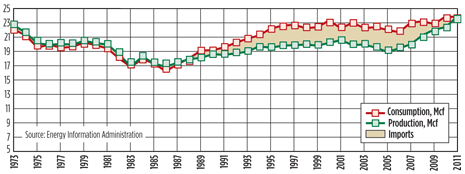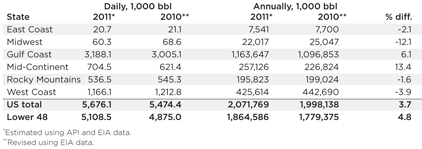|
Crude and condensate. Strong and consistent oil prices kept U.S. crude production climbing in 2011, though only modestly, in the Lower 48 states, offsetting a continued decline in Alaska. Overall, U.S. production climbed an estimated 3.7%, while Alaska, once the Gargantua of production and reserves, fell another 5.3% from 2010’s revised rate of just under 600,000 bopd. Since peaking at over 2 million bopd in 1987, the decline of Alaskan fields has been steady and nearly linear to an average 567,000 bopd last year, a fall of over two-thirds.
In purely percentage terms, the shining light of domestic crude production was North Dakota. Due primarily to a drilling boom in the Williston basin, production from the state’s Bakken shale increased by 23.3% to a record 381,800 bopd in 2011. With oil prices showing no sign of a collapse, there is no reason not to expect another record–setter this year. (Not coincidentally, North Dakota also boasted the nation’s highest percentage employment rate, as petroleum industry jobs mopped up all available labor and brought thousands of hopeful workers from other states and countries.)
Another bright spot was Texas, where the biggest push was in conventional oil from mature plays. These low-risk areas contributed most to the state’s 12.1% increase. With liquids commanding a greater and greater share of the drilling industry’s attention, Texas crude production rose to nearly 1.7 million bopd in 2011, a level not seen since the mid–1990s.
Louisiana posted a more modest increase to over 1.4 million bopd, the lion’s share of that offshore. Kansas crude production rose 7.7% last year to almost 120,000 bpd. Horizontal drilling and hydrofracing, mostly in the southern counties of the state, have become economic options justified by sky-high oil prices, offsetting the mostly disappointing natural gas industry.
Even though oil production jumped nationally, losers outnumbered gainers 3-to-1 among the producing states. The worst performer in percentage terms was Michigan, which saw its modest petroleum production plummet by over 30% to barely 10,000 bopd. This is compared to over 85,000 bopd seen in the boom days of the early 1980s. Although the Great Lakes region has substantial reserves of natural gas, the traditional oil fields are playing out, and are not being replaced. California continued its downward trend, slipping below 600,000 bopd for the first time since late 2008.
 |
| U.S. gas consumption and marketed gas production, Tcf |
|
Natural gas. Despite low wellhead prices threatening to take the wind out of its sails, natural gas production in the U.S. continued at a strong pace. The first 10 months of 2011 saw over 66 Bcfd of marketed production nationwide. Texas accounted for the largest share, coming in at 19.3 Bcfd in the first three quarters of 2011. Louisiana was in second place with some 8.3 Bcfd in the same period, the most recent months available. Increases in onshore production more than offset declines offshore. Overall, demand for natural gas in the U.S. has remained strong year to year, particularly in the industrial and electrical-generation sectors.
Overall, the consumption/marketed production spread has diminished steadily since 2007 (see graph). With an estimated 23.8 Tcf of total gas consumption and 23.9 Tcf production for 2011, net natural gas importation has effectively disappeared.
| U.S. crude and condensate production by region |
 |
As drillers shift emphasis to more profitable crude oil, there is hope that the broad gap between abundant supplies of natural gas and growing demand will shrink further, strengthening prices. In the meantime, with prices sagging to lows not seen since the bottom of the economic downturn in mid-2009, there is little incentive for companies to develop existing reserves. 
|




